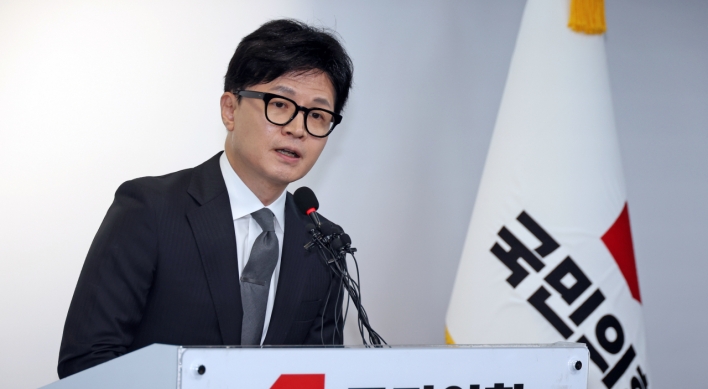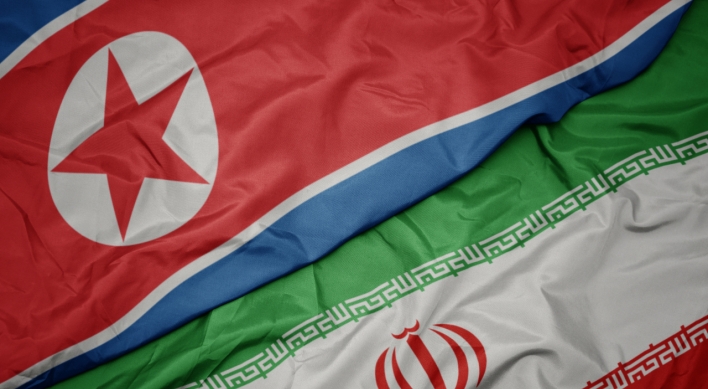South Korea, U.S. seek to strengthen missile intelligence cooperation
South Korea plans to fully deploy ballistic missiles with ranges of 550 km and 800 km within five years as Seoul and Washington have revised a bilateral guideline governing its missile development.
A senior Seoul official said that the government had earmarked some 2.4 trillion won ($2.16 billion) for a five-year plan, starting from next year, to develop and deploy these longer-range missiles.
“We aim to deploy these ballistic missiles, for full-fledged operations, in five years. We have requested that 500 billion won be set aside annually to implement the plan,” said the official, declining to be named.
“The budget proposal has been handed over to the National Assembly and what matters now is whether the legislature will accept it.”
Having led the negotiations with Washington, Cheong Wa Dae announced Sunday that the allies agreed to revise the 2001 guideline to allow Seoul to develop ballistic missiles with a range of up to 800 km, up from the previous 300 km.
The extended range, from South Korea’s central region, covers all military sites in the communist state. The two had been in intense talks since early last year to better deal with North Korea’s increasing missile threats.
The revision applies a “trade-off” principle in which the payload weight can increase in inverse proportion to its range. The weight is to remain at 500 kg as it was, when the range is 800 km, but it could more than triple if the range is 300 km.
Military officials say that it would not take much time to develop longer-range missiles as Seoul has long conducted research on ballistic missiles. The previous deal did not restrict research activities.
“In preparation of future needs, we have accumulated our (missile) technology continuously and are considerably close to completing the technology required for longer-range missiles,” Major Gen. Shin Won-sik, the Defense Ministry’s policy planning director general, told reporters.
Meanwhile, Seoul and Washington reportedly plan to strengthen their cooperation in sharing intelligence on North Korea’s missile activities, which is gathered by U.S. reconnaissance and surveillance assets such as satellites and spy drones.
At the annual Security Consultative Meeting slated to be held in Washington on Oct. 24, the allies are expected to discuss ways to link such U.S. intelligence on North Korea to the operation of the Korea Air Missile Defense system, so as to enhance the combined digital command system called “C4I,”or Command Control Communication Computer and Intelligence.
The KAMD system is a low-tier missile defense program, tailored for South Korean terrain. It is designed to intercept hostile missiles or combat aircraft at an altitude of 10-30 kilometers.
The allies have conducted joint research on developing the system after agreeing on the study in September 2010.
As the two sides deepen their missile cooperation, some have raised the possibility that South Korea could join a broader U.S.-led missile defense program. Seoul officials have dismissed the suggestion.
The U.S.-led MD program aims to intercept intercontinental ballistic missiles heading toward its mainland with ground-based interceptors for high-altitude targets, ship-based Standard Missile 3 for mid-altitude targets or Patriot Advanced Capability-3 for low-altitude missions.
The U.S. has long demanded Seoul’s participation. Seoul, however, has sought to develop the KAMD program due to the high cost for the global MD participation and possible opposition from China.
By Song Sang-ho (sshluck@heraldcorp.com)
South Korea plans to fully deploy ballistic missiles with ranges of 550 km and 800 km within five years as Seoul and Washington have revised a bilateral guideline governing its missile development.
A senior Seoul official said that the government had earmarked some 2.4 trillion won ($2.16 billion) for a five-year plan, starting from next year, to develop and deploy these longer-range missiles.
“We aim to deploy these ballistic missiles, for full-fledged operations, in five years. We have requested that 500 billion won be set aside annually to implement the plan,” said the official, declining to be named.
“The budget proposal has been handed over to the National Assembly and what matters now is whether the legislature will accept it.”
Having led the negotiations with Washington, Cheong Wa Dae announced Sunday that the allies agreed to revise the 2001 guideline to allow Seoul to develop ballistic missiles with a range of up to 800 km, up from the previous 300 km.
The extended range, from South Korea’s central region, covers all military sites in the communist state. The two had been in intense talks since early last year to better deal with North Korea’s increasing missile threats.
The revision applies a “trade-off” principle in which the payload weight can increase in inverse proportion to its range. The weight is to remain at 500 kg as it was, when the range is 800 km, but it could more than triple if the range is 300 km.
Military officials say that it would not take much time to develop longer-range missiles as Seoul has long conducted research on ballistic missiles. The previous deal did not restrict research activities.
“In preparation of future needs, we have accumulated our (missile) technology continuously and are considerably close to completing the technology required for longer-range missiles,” Major Gen. Shin Won-sik, the Defense Ministry’s policy planning director general, told reporters.
Meanwhile, Seoul and Washington reportedly plan to strengthen their cooperation in sharing intelligence on North Korea’s missile activities, which is gathered by U.S. reconnaissance and surveillance assets such as satellites and spy drones.
At the annual Security Consultative Meeting slated to be held in Washington on Oct. 24, the allies are expected to discuss ways to link such U.S. intelligence on North Korea to the operation of the Korea Air Missile Defense system, so as to enhance the combined digital command system called “C4I,”or Command Control Communication Computer and Intelligence.
The KAMD system is a low-tier missile defense program, tailored for South Korean terrain. It is designed to intercept hostile missiles or combat aircraft at an altitude of 10-30 kilometers.
The allies have conducted joint research on developing the system after agreeing on the study in September 2010.
As the two sides deepen their missile cooperation, some have raised the possibility that South Korea could join a broader U.S.-led missile defense program. Seoul officials have dismissed the suggestion.
The U.S.-led MD program aims to intercept intercontinental ballistic missiles heading toward its mainland with ground-based interceptors for high-altitude targets, ship-based Standard Missile 3 for mid-altitude targets or Patriot Advanced Capability-3 for low-altitude missions.
The U.S. has long demanded Seoul’s participation. Seoul, however, has sought to develop the KAMD program due to the high cost for the global MD participation and possible opposition from China.
By Song Sang-ho (sshluck@heraldcorp.com)
-
Articles by Korea Herald



![[Exclusive] Korean military set to ban iPhones over 'security' concerns](http://res.heraldm.com/phpwas/restmb_idxmake.php?idx=644&simg=/content/image/2024/04/23/20240423050599_0.jpg&u=20240423183955)

![[Graphic News] 77% of young Koreans still financially dependent](http://res.heraldm.com/phpwas/restmb_idxmake.php?idx=644&simg=/content/image/2024/04/22/20240422050762_0.gif&u=)



![[Pressure points] Leggings in public: Fashion statement or social faux pas?](http://res.heraldm.com/phpwas/restmb_idxmake.php?idx=644&simg=/content/image/2024/04/23/20240423050669_0.jpg&u=)










